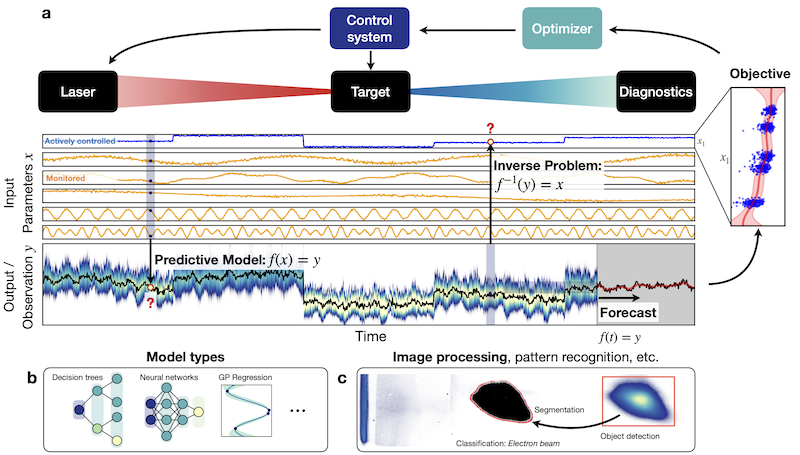Machine learning in Laser Physics
The DOLPHIN research team at the Centre for Advanced Laser Applications (CALA) stands at the forefront of ultra-intense laser physics by blending advanced computational methods with deep physics know-how. In collaboration with premier institutions globally, the team is dedicated to expanding the horizons of high-power laser physics, aiming to foster transformative technologies that offer societal benefits. Their innovative approach of integrating state-of-the-art machine learning with physics expertise is leading to more precise and efficient strategies for optimizing laser-plasma interactions. This effort is set to unlock novel applications in particle acceleration, attosecond science, and high-field physics.
For an introduction to our research, please consult the review paper:
- Data-driven science and machine learning methods in laser–plasma physics
A. Döpp, C. Eberle, S. Howard, F. Irshad, J. Lin, M. Streeter
High Power Laser Science and Engineering, 11, 55 (2023)
Exploring how the DOLPHIN group uses machine learning in laser-plasma physics. (a) Shows a basic setup for laser-plasma experiments or simulations, where we control and observe various aspects of the laser and its target. We know some parameters (like laser energy and plasma density) and can adjust them. However, other factors we either just monitor or don't know at all, which can add uncertainty or "noise" to our results. Using machine learning, we predict outcomes (output y) based on what we know (input parameters x), as detailed in (b). Sometimes, we work backwards from the outcomes to guess the starting conditions or track how things change over time. We use these predictions to improve our experiments, tweaking the laser and target settings based on what we've learned. Part (c) involves using machine learning for tasks like analyzing images from the experiments to spot specific patterns or features.
AI-assisted diagnostics for high-power lasers
Light pulses are characterized by their spectrum, polarization and direction (the "light field" or "wavefront"). However, measuring the 3-D vectorfield on a 2-D detector poses a formidable challenge that requires innovation in both optics and data processing. One key focus is the development of advanced diagnostics that can reconstruct complex spatio-temporal couplings from limited data. The group has developed FALCON (Fast Acquisition of Laser Couplings using Narrowband Filters), a novel diagnostic that enables quantitative single-shot measurements of these couplings [1]. FALCON combines multi-spectral wavefront sensing with a modal reconstruction algorithm, providing an essential tool for optimizing the performance of high-power lasers. The group is also exploring the use of Compressed Sensing and Bayesian inference to redefine the concept of single-shot measurements [2], adapting it to the specific prior knowledge and desired learning outcomes for a given laser system. This approach allows for the retrieval of key spatio-temporal couplings beyond the limitations of traditional sampling theory.
- Measuring spatio-temporal couplings using modal spatio-spectral wavefront retrieval
N. Weisse, J. Esslinger, S. Howard, F. M. Foerster, F. Haberstroh, L. Doyle, P. Norreys, J. Schreiber, S. Karsch, and A. Döpp
Opt. Express 31, 19733-19745 (2023) - Hyperspectral Compressive Wavefront Sensing
S. Howard, J. Esslinger, R. H. W. Wang, P. Norreys, A. Döpp
High Power Laser Science and Engineering, 11, 32 (2023)
Efficient optimization of laser-plasma accelerators
Another major research area is the optimization of laser-plasma accelerators, which hold great promise for compact sources of high-energy particles and radiation. However, optimizing the performance of these devices is challenging due to the complex, high-dimensional parameter space and often competing objectives. The DOLPHIN group has developed advanced Bayesian optimization techniques that efficiently explore this parameter space and identify optimal operating points. These methods build and refine a probabilistic model of the laser-plasma accelerator during operation and use explainable decision policies to efficiently steer the accelerator towards the desired performance [1,2].
- Multi-objective and multi-fidelity Bayesian optimization of laser-plasma acceleration
F. Irshad, S. Karsch, and A. Döpp
Physical Review Research, 5, 013063 (2023) - Pareto Optimization of a Laser Wakefield Accelerator
F. Irshad, C. Eberle, F.M. Foerster, K. v. Grafenstein, F. Haberstroh, E. Travac, N. Weisse, S. Karsch and A. Döpp
under review / arXiv (2023)
Advancing machine learning methods
In addition to applying machine learning techniques to laser physics, the DOLPHIN group is actively contributing to the advancement of machine learning methods themselves. One notable example is the development of CoordGate, a novel module that enables the efficient computation of spatially-varying convolutions in convolutional neural networks [1]. CoordGate uses a multiplicative gate and a coordinate encoding network to allow for selective amplification or attenuation of filters based on their spatial position. This approach outperforms conventional methods and offers a more robust and spatially aware solution for various computer vision applications. The group also proposed Trust-MOMF, a high-performance algorithm for Bayesian optimization of multiple objectives using multiple information sources [2].
- CoordGate: Efficiently Computing Spatially-Varying Convolutions in Convolutional Neural Networks
Sunny Howard, Peter Norreys, Andreas Döpp
British Machine Vision Conference (2023) - Leveraging Trust for Joint Multi-Objective and Multi-Fidelity Optimization
Faran Irshad, Stefan Karsch and Andreas Döpp
Machine Learning: Science and Technology (2024)
Project Coordinator: Andreas Döpp


